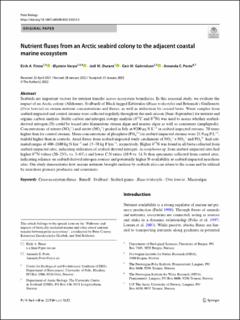| dc.contributor.author | Finne, Eirik Aasmo | |
| dc.contributor.author | Varpe, Øystein | |
| dc.contributor.author | Durant, Joël | |
| dc.contributor.author | Gabrielsen, Geir W. | |
| dc.contributor.author | Poste, Amanda | |
| dc.date.accessioned | 2022-04-22T11:46:37Z | |
| dc.date.available | 2022-04-22T11:46:37Z | |
| dc.date.created | 2022-03-22T15:58:27Z | |
| dc.date.issued | 2022 | |
| dc.identifier.issn | 0722-4060 | |
| dc.identifier.uri | https://hdl.handle.net/11250/2992286 | |
| dc.description.abstract | Seabirds are important vectors for nutrient transfer across ecosystem boundaries. In this seasonal study, we evaluate the impact of an Arctic colony (Alkhornet, Svalbard) of Black-legged Kittiwakes (Rissa tridactyla) and Brünnich’s Guillemots (Uria lomvia) on stream nutrient concentrations and fuxes, as well as utilization by coastal biota. Water samples from seabird-impacted and control streams were collected regularly throughout the melt season (June–September) for nutrient and organic carbon analysis. Stable carbon and nitrogen isotope analysis (δ13C and δ15N) was used to assess whether seabird derived nitrogen (N) could be traced into flamentous stream algae and marine algae as well as consumers (amphipods). Concentrations of nitrate (NO3−) and nitrite (NO2) peaked in July at 9200 µg N L−1 in seabird-impacted streams, 70 times higher than for control streams. Mean concentrations of phosphate (PO4 3−) in seabird-impacted streams were 21.9 µg P L−1, tenfold higher than in controls. Areal fuxes from seabird-impacted study catchments of NO3− + NO2− and PO4 3− had estimated ranges of 400–2100 kg N km−2 and 15–70 kg P km−2, respectively. Higher δ15N was found in all biota collected from seabird-impacted sites, indicating utilization of seabird-derived nitrogen. Acrosiphonia sp. from seabird-impacted sites had higher δ15N values (20–23‰ vs. 3–6‰) and lower C:N ratios (10.9 vs. 14.3) than specimens collected from control sites, indicating reliance on seabird-derived nitrogen sources and potentially higher N-availability at seabird-impacted nearshore sites. Our study demonstrates how marine nutrients brought onshore by seabirds also can return to the ocean and be utilized by nearshore primary producers and consumers. Cross-ecosystem fuxes · Runof · Svalbard · Seabird guano · Rissa tridactyla · Uria lomvia · Macroalgae | en_US |
| dc.language.iso | eng | en_US |
| dc.publisher | Springer | en_US |
| dc.rights | Navngivelse 4.0 Internasjonal | * |
| dc.rights.uri | http://creativecommons.org/licenses/by/4.0/deed.no | * |
| dc.title | Nutrient fuxes from an Arctic seabird colony to the adjacent coastal marine ecosystem | en_US |
| dc.type | Journal article | en_US |
| dc.type | Peer reviewed | en_US |
| dc.description.version | publishedVersion | en_US |
| dc.rights.holder | Copyright 2022 The Author(s) | en_US |
| cristin.ispublished | true | |
| cristin.fulltext | original | |
| cristin.qualitycode | 1 | |
| dc.identifier.doi | 10.1007/s00300-022-03024-5 | |
| dc.identifier.cristin | 2011795 | |
| dc.source.journal | Polar Biology | en_US |
| dc.relation.project | Egen institusjon: University Centre in Svalbard | en_US |
| dc.relation.project | Norges forskningsråd: 268458 | en_US |
| dc.relation.project | Egen institusjon: University of Oslo | en_US |
| dc.relation.project | Andre: Jan Christensen’s endowment grant | en_US |
| dc.relation.project | Andre: The Nansen Legacy; No. 276730) | en_US |
| dc.subject.nsi | VDP::Zoologiske og botaniske fag: 480 | en_US |
| dc.subject.nsi | VDP::Zoology and botany: 480 | en_US |
| dc.identifier.citation | Polar Biology. 2022 | en_US |

